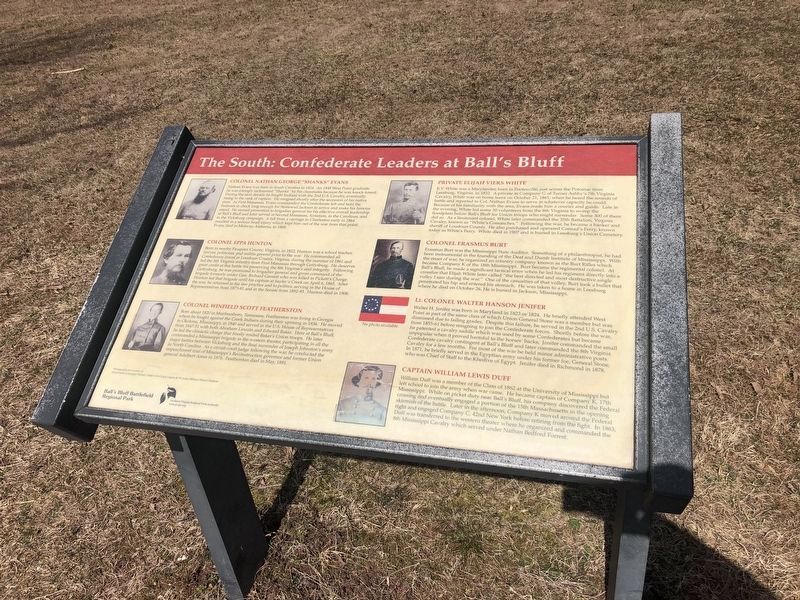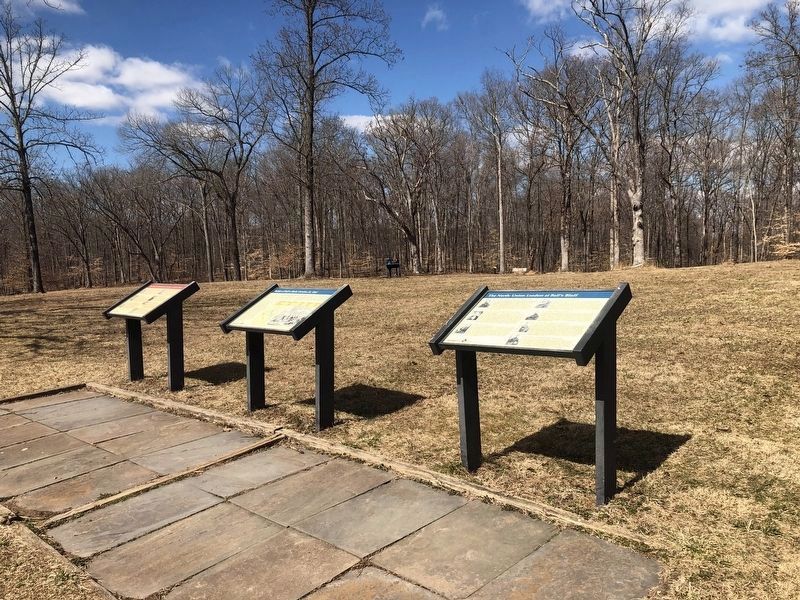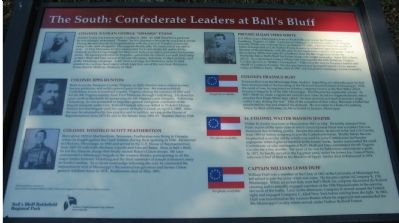Leesburg in Loudoun County, Virginia — The American South (Mid-Atlantic)
The South: Confederate Leaders at Ballís Bluff

Photographed By Devry Becker Jones (CC0), March 6, 2021
1. The South: Confederate Leaders at Ballís Bluff Marker
Colonel Nathan George “Shanks” Evans
Nathan Evans was born in South Carolina in 1824. An 1848 West Point graduate, he was jokingly nicknamed “Shanks” by his classmates because he was knock-kneed. During the next decade he fought Indians with the 2nd U.S. Cavalry, eventually rising to the rank of captain. He resigned shortly after the secession of his native state. At First Manassas, Evans commanded the Confederate left and held the Federals in check long enough for Stonewall Jackson to arrive and make his famous stand. He earned promotion to brigadier general for his effective overall leadership at Ballís Bluff and later served at Second Manassas, Antietam, in the Carolinas, and in the Vicksburg campaign. A fall from a carriage in Charleston early in 1864 resulted in a serious head injury which kept him out of the war from that point. Evans died in Midway, Alabama, in 1868.
Colonel Eppa Hunton
Born in nearby Fauquier County, Virginia, in 1822, Hunton was a school teacher lawyer, politician, and militia general prior to the war. He commanded all Confederate forces in Loudoun County, Virginia, during the summer of 1861 and led the 8th Virginia infantry from First Manassas through Gettysburg. He deserves great credit at this battle for preserving the 8th Virginiaís unit integrity. Following Gettysburg, he was promoted to brigadier general and given command of the brigade formerly under Gen. Richard Garnett who was killed in Pickettís Charge. Hunton led that brigade until his capture at Saylerís Creek on April 6, 1865. After the war, he returned to his law practice and to politics, serving in the House of Representatives from 1873-81 and in the Senate from 1892-95. Hunton died in 1908.
Colonel Winfield Scott Featherston
Born about 1820 in Murfreesboro, Tennessee, Featherston was living in Georgia where he fought against the Creek Indians during their uprising in 1836. He moved to Okolona, Mississippi, in 1840 and served in the U.S. House of Representatives from 1847-51 with both Abraham Lincoln and Edward Baker. Here at Ballís Bluff, he led the climactic charge that finally routed Bakerís Union troops. He later commanded a Mississippi brigade in the western theater, participating in all the major battles between Vicksburg and the final surrender of Joseph Johnstonís army in North Carolina. As a circuit court judge following the war, he conducted the impeachment trial of Mississippi's Reconstruction governor and former Union general Adelbert Ames in 1876. Featherston died in May, 1891.
Private Elijah Viers White
E.V. White was a Marylander, born in Poolesville, just across the Potomac from Leesburg, Virginia, in 1832. A private
in Company G of Turner Ashbyís 7th Virginia Cavalry, White was home on leave on October 21, 1861, when he heard the sounds of battle and reported to Col. Nathan Evans to serve in whatever capacity he could. Because of his familiarity with the area, Evans made him a courier and guide. Late in the evening, White led some 50 volunteers from the 8th Virginia to sweep the floodplain below Ballís Bluff for Union troops who might surrender. Some 300 of them did so. As a lieutenant colonel, White later commanded the 35th Battalion, Virginia Cavalry, known as “Whiteís Comanches.” Following the war, he became a banker and sheriff of Loudoun County. He also purchased and operated Conradís Ferry, known today as Whiteís Ferry. White died in 1907 and is buried in Leesburgís Union Cemetery.
Colonel Erasmus Burt
Erasmus Burt was the Mississippi State Auditor. Something of a philanthropist, he had been instrumental in the founding of the Deaf and Dumb Institute of Mississippi. With the onset of war, he organized an infantry company known as the Burt Rifles which became Company K of the 18th Mississippi. Burt became the regimental colonel. At Ballís Bluff, he made a significant tactical error when he led his regiment directly into a crossfire that Elijah White later called “the best directed and most destructive single volley I saw during the war.” One of

Photographed By Devry Becker Jones (CC0), March 6, 2021
3. The South: Confederate Leaders at Ballís Bluff Marker
Colonel Walter Hanson Jenifer
Walter H. Jenifer was born in Maryland in 1823 or 1824. He briefly attended West Point as part of the same class of which Union General Stone was a member but was dismissed due to failing grades. Despite this failure, he served in the 2nd U.S. Cavalry from 1855-61 before resigning to join the Confederate forces. Shortly before the war, he patented a cavalry saddle which was used by some Confederates but became unpopular when it proved harmful to the horsesí backs. Jenifer commanded the small Confederate cavalry contingent at Ballís Bluff and later commanded the 8th Virginia Cavalry for a few months. For most of the war he held minor administrative posts. In 1871, he briefly served in the Egyptian army under his former foe, General Stone, who was Chief of Staff to the Khedive of Egypt. Jenifer died in Richmond in 1878.
Captain William Lewis Duff
William Duff was a member of the Class of 1862 at the University of Mississippi but left school to join the army when war came. He became captain of Company K, 17th Mississippi. While on picket duty near Ballís Bluff, his company discovered the Federal crossing and eventually engaged a portion of the 15th Massachusetts in the opening skirmish of the battle. Later in the afternoon, Company K moved around the Federal right and engaged Company C, 42nd New York before retiring from the fight. In 1863, Duff was transferred to the western theater where he organized and commanded the 8th Mississippi Cavalry which served under Nathan Bedford Forrest.
Erected by Ballís Bluff Regional Park/Northern Virginia Regional Park Authority.
Topics and series. This historical marker is listed in this topic list: War, US Civil. In addition, it is included in the NOVA Parks series list. A significant historical month for this entry is April 1863.
Location. 39° 7.915′ N, 77° 31.676′ W. Marker is in Leesburg, Virginia, in Loudoun County. Marker can be reached from Ballís Bluff Road, on the left when traveling east. To the west of the National Cemetery, Ballís Bluff Regional Park. Touch for map. Marker is in this post office area: Leesburg VA 20175, United States of America. Touch for directions.
Other nearby markers. At least 8 other markers are within walking distance of this marker. Battle of Ball's Bluff, October 21, 1861 (here, next to this marker); First Black Combatant of the Civil War (here, next to this marker); Thomas Clinton Lovett Hatcher (here, next to this marker); The North: Union Leaders at Ball's Bluff (a few steps from this marker); Clinton Hatcher (a few steps from this marker); 13 Pounder "James Rifle" (within shouting distance of this marker); A National Cemetery System (within shouting distance of this marker); United States National Military Cemetery (within shouting distance of this marker). Touch for a list and map of all markers in Leesburg.
More about this marker. The marker displays portraits of Colonels Evans, Hunton, Featherston, and White.
Regarding The South: Confederate Leaders at Ballís Bluff. This marker is one of a set along the Balls Bluff Battlefield walking trail. See the Balls Bluff Virtual Tour by Markers link below for details on each stop.
Credits. This page was last revised on March 7, 2021. It was originally submitted on August 31, 2007. This page has been viewed 3,149 times since then and 37 times this year. Last updated on October 9, 2020, by Bradley Owen of Morgantown, West Virginia. Photos: 1. submitted on March 7, 2021, by Devry Becker Jones of Washington, District of Columbia. 2. submitted on September 1, 2007, by Craig Swain of Leesburg, Virginia. 3. submitted on March 7, 2021, by Devry Becker Jones of Washington, District of Columbia. • J. Makali Bruton was the editor who published this page.
